The Intel Haswell-E CPU Review: Core i7-5960X, i7-5930K and i7-5820K Tested
by Ian Cutress on August 29, 2014 12:00 PM ESTCPU Benchmarks
The dynamics of CPU Turbo modes, with both Intel and AMD, can cause concern during environments with a variable threaded workload. There is also an added issue of the motherboard remaining consistent, depending on how the motherboard manufacturer wants to add in their own boosting technologies over the ones that the CPU manufacturer would prefer they used. In order to remain consistent, we implement an OS-level unique high performance mode on all the CPUs we test which should override any motherboard manufacturer performance mode.
HandBrake v0.9.9: link
For HandBrake, we take two videos (a 2h20 640x266 DVD rip and a 10min double UHD 3840x4320 animation short) and convert them to x264 format in an MP4 container. Results are given in terms of the frames per second processed, and HandBrake uses as many threads as possible.
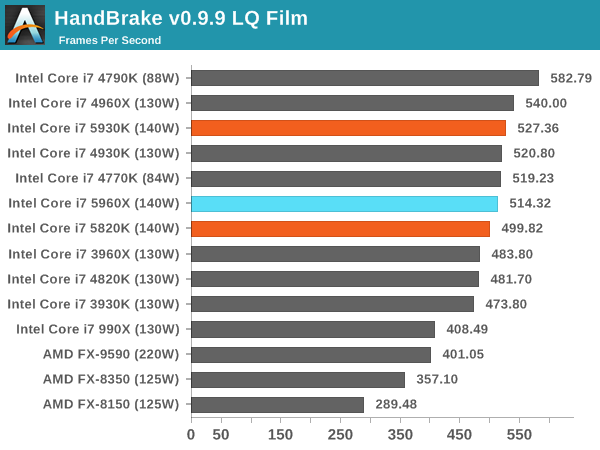
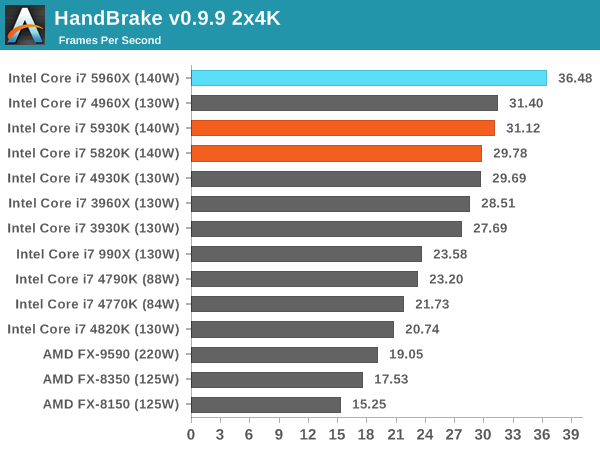
The variable turbo speeds of the CPUs results in a small difference in low quality conversion, and the high single core frequency of the 4790K wins there. For 4K conversion the problem becomes more parallel and the extra cores of the 5960X push it ahead of the pack. The 5930K and 5820K are both behind the 4960X however.
Agisoft Photoscan – 2D to 3D Image Manipulation: link
Agisoft Photoscan creates 3D models from 2D images, a process which is very computationally expensive. The algorithm is split into four distinct phases, and different phases of the model reconstruction require either fast memory, fast IPC, more cores, or even OpenCL compute devices to hand. Agisoft supplied us with a special version of the software to script the process, where we take 50 images of a stately home and convert it into a medium quality model. This benchmark typically takes around 15-20 minutes on a high end PC on the CPU alone, with GPUs reducing the time.
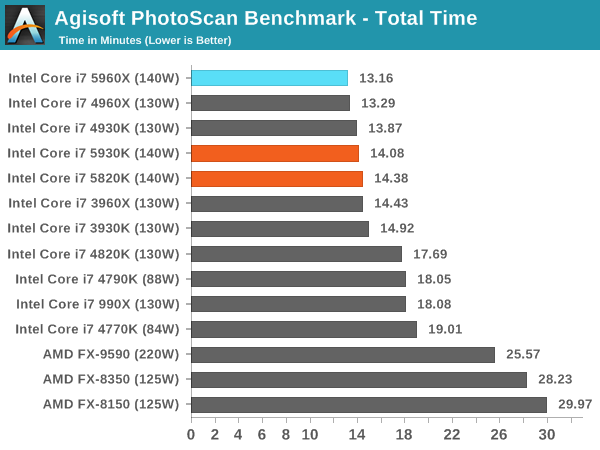
Photoscan's four separate components rely on different amounts of high frequency vs. many cores: check our Bench database for more detailed results but overall the 5960X comes out on top. That being said, the 5820K is less than 40% of the price and is only 1.2 minutes behind.
Dolphin Benchmark: link
Many emulators are often bound by single thread CPU performance, and general reports tended to suggest that Haswell provided a significant boost to emulator performance. This benchmark runs a Wii program that raytraces a complex 3D scene inside the Dolphin Wii emulator. Performance on this benchmark is a good proxy of the speed of Dolphin CPU emulation, which is an intensive single core task using most aspects of a CPU. Results are given in minutes, where the Wii itself scores 17.53 minutes.
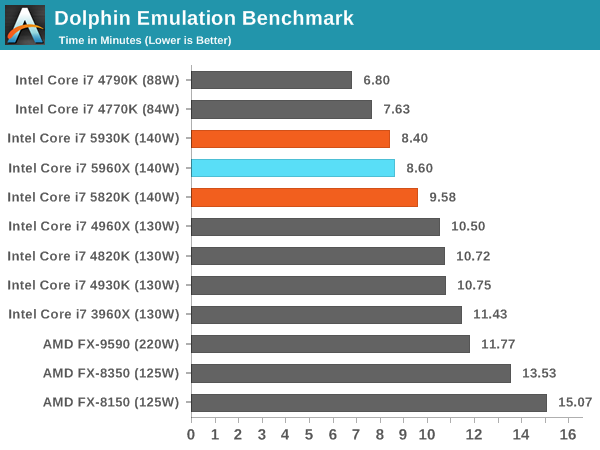
Dolphon loves single core speed and efficiency, meaning the 4790K wins out again. Interestingly the large L3 cache of the 5960X also helps here against the 5820K, despite the 5820K having a higher single thread frequency.
WinRAR 5.0.1: link
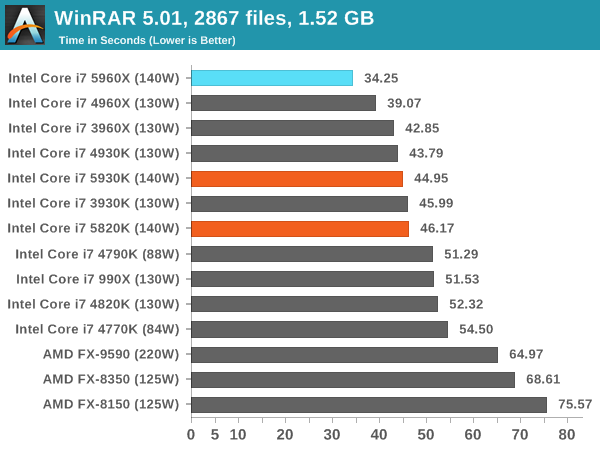
WinRAR is a variable thread workload, but more cores still wins out. Interestingly the xx60X CPUs are ahead of the xx30K CPUs followed by the xx20K. After this comes the 4790K, and then the 990X on par, showing how far three generations of Intel CPU have developed.
PCMark8 v2 OpenCL
A new addition to our CPU testing suite is PCMark8 v2, where we test the Work 2.0 and Creative 3.0 suites in OpenCL mode.
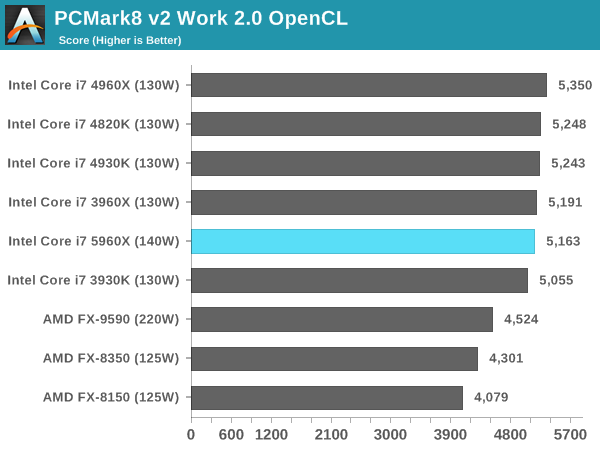
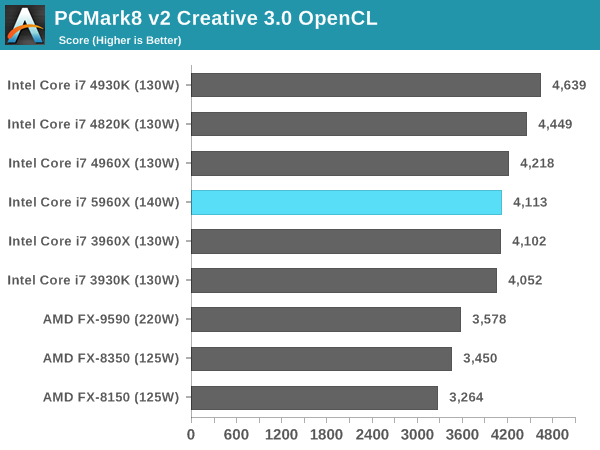
PCMark v8 relies on a number of factors, and it would seem that frequency is preferred over cache and memory. Interestingly the 4930K beat the 4960X in the Creative Suite with no obvious explanation.
Hybrid x265: link
Hybrid is a new benchmark, where we take a 4K 1500 frame video and convert it into an x265 format without audio. Results are given in frames per second.

Converting 4K video gets another step in the preference for more cores in Hybrid x265. The 5820K matches the 3960X, showing the progression of CPU generational development.
Cinebench R15
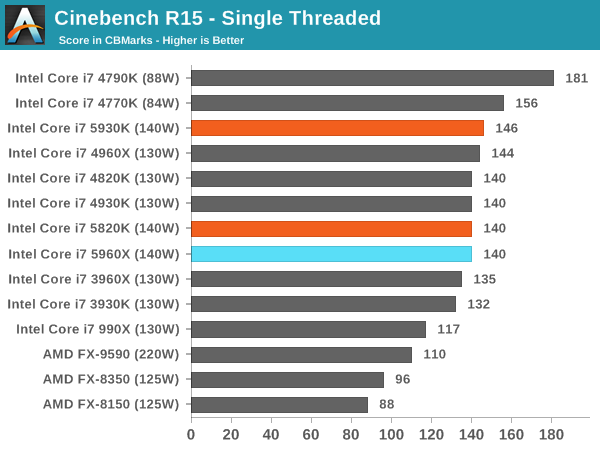
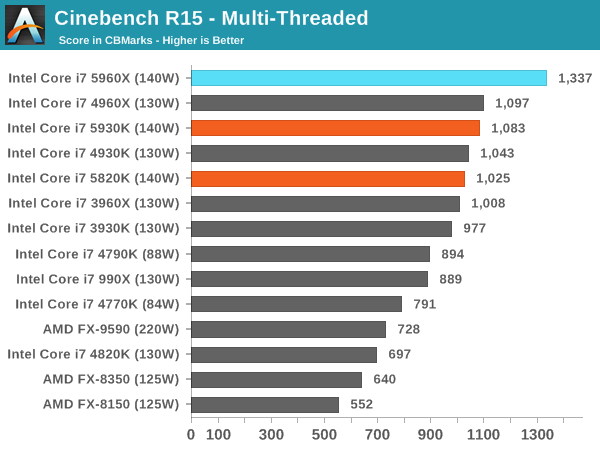
3D Particle Movement
3DPM is a self-penned benchmark, taking basic 3D movement algorithms used in Brownian Motion simulations and testing them for speed. High floating point performance, MHz and IPC wins in the single thread version, whereas the multithread version has to handle the threads and loves more cores.
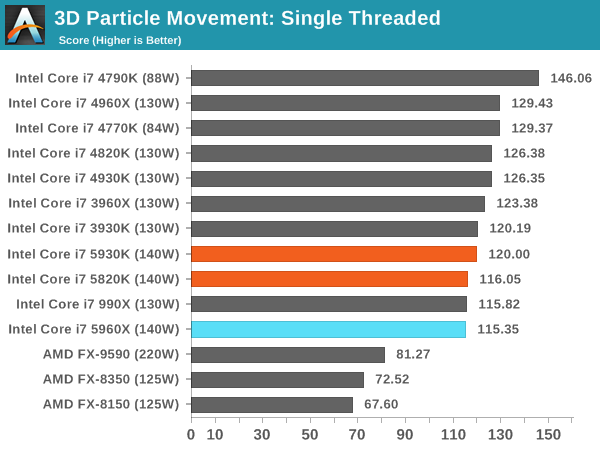

FastStone Image Viewer 4.9
FastStone is the program I use to perform quick or bulk actions on images, such as resizing, adjusting for color and cropping. In our test we take a series of 170 images in various sizes and formats and convert them all into 640x480 .gif files, maintaining the aspect ratio. FastStone does not use multithreading for this test, and results are given in seconds.
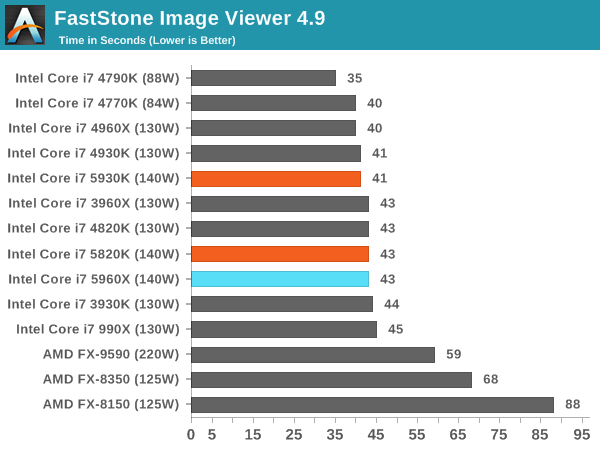
FastStone is a purely single threaded exercise, showing here how the lower core CPUs with high turbo perfom best, and by quite a margin.










203 Comments
View All Comments
akLuckyCharm - Saturday, August 30, 2014 - link
Thank you Anand Tech for showing performance with ALL of the cpus overclocked as apposed to only one chip overclocked and the rest at stock. This makes the comparison much more fair and realistic.MrSpadge - Saturday, August 30, 2014 - link
I really like the analysis of performance per clock. It really helps me to judge CPU performance. However, why do you disable HT for these tests? All the CPUs considered have it, and on average it boosts performance. And most importantly:"Haswell bought... two new execution ports and increased buffers to feed an increased parallel set of execution resources... Intel doubled the L1 cache bandwidth."
Right. Which means Haswell may very well see better performance improvements from enabling HT than older CPUs. This could be very relevant for the workloads which people should run on these 6 and 8 core monsters. And by that I'm not talking about gaming ;)
vision33r - Sunday, August 31, 2014 - link
Most people don't need this setup because the only thing here is really your Haswell processor with couple of extra cores, a few different parts for DDR4, and a little bump here in L2 and that's it. Games don't need all of these changes because most games today are sophisticated enough to utilize them.I can certainly see that my VM and rendering machine will love the new 5960X and DDR4 but it's not worth investing in new platform when it just came out.
Anyone that does high end AV content creation will see a big bump if you got the money to spend on it.
HongKonger1997 - Sunday, August 31, 2014 - link
So if I only game with computer, my 3960X is still good?MrSpadge - Sunday, August 31, 2014 - link
Of course. Even a Sandy Bridge i5 would easily do the jpb, a 3960X is actually complete overkill.Artemis *Seven* - Sunday, August 31, 2014 - link
All great benchmarks except for the gaming ones. It's pretty common knowledge that Geforce cards like to handle almost everything "in-house" whereas AMDs tend to dump a big chunk of their workload onto the CPU. All I'm saying is that I'd love to see a gaming benchmark redone with R9's - I'm betting it would show the differences between these processors in games better - if there are actually any :Dmlambert890 - Monday, September 1, 2014 - link
the differences are minor with PURE cpu tests. sandy e to ivy e is about 5% ipc gain. ivy e to hw e is another 8% or so, but it suffers a 10% oc ceiling deficit against them and it has higher latency ram to boot.unless your workload truly has 8 threads or you multitask to the point you are saturating 6 fast cores this is a non upgrade coming from sandy or ivy
woj666 - Sunday, August 31, 2014 - link
It's curious why they used the dud 5960 results for overclocking vs the one that kept up to the 4790 in overclocking. I detect some 4 core bias here.A 5960@4.0 will run at the same temperature as a 4790@4.0.
mlambert890 - Monday, September 1, 2014 - link
double the active cores at same clock rate equals lots more power which equals lots more heat. notice the tdp values?faster - Sunday, August 31, 2014 - link
I might finally upgrade my work computer. I'm running an i7 920 with 8gb memory and a 256 GB SSD drive. I need that extra power for word processing, emailing, and surfing the web. Oh wait, no I don't. For the basic computer user, computers have been fast enough for many years.For my home gaming machine, I don't see a reason to upgrade my 4770k.